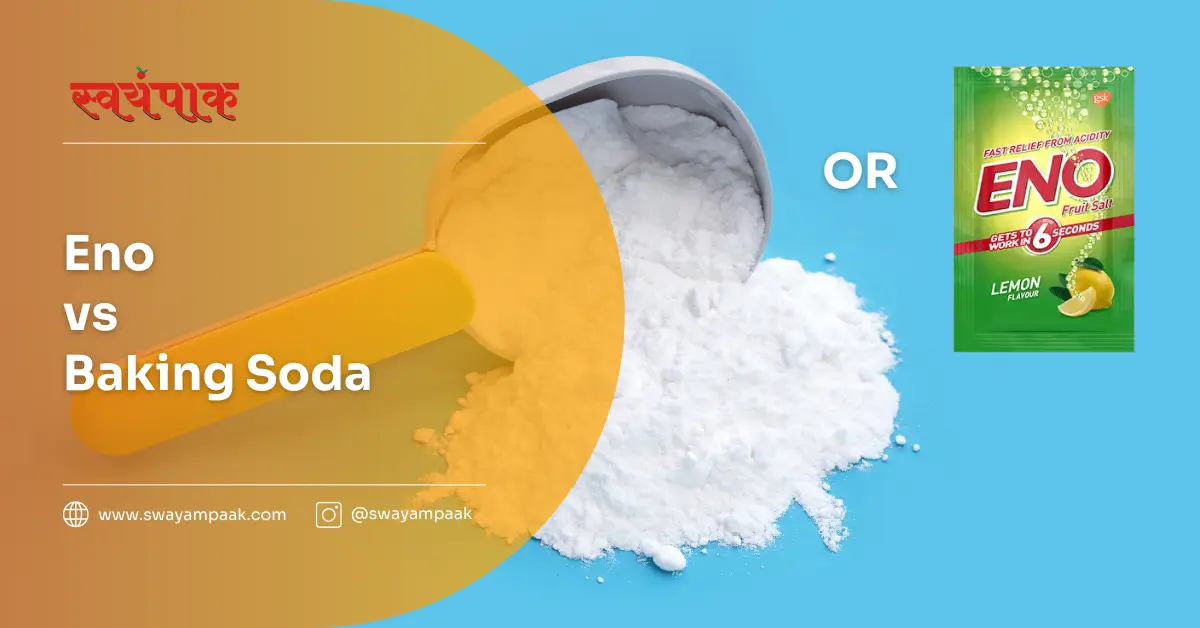Eno vs Baking Soda: What’s the Difference and Which Should You Use?
Eno and baking soda may look alike, but they behave very differently in your recipes.
Eno is a fruit salt composed of sodium bicarbonate, citric acid, and sodium carbonate, used as both a fast-acting leavening agent and an antacid. Baking soda, on the other hand, is pure sodium bicarbonate and needs an acidic ingredient (like lemon juice or curd) to work effectively in cooking.
Eno is ideal for quick recipes like dhokla and idli due to its instant fizz, while baking soda is best for baked goods like cakes and cookies that already include acidic ingredients.
In this blog, you’ll discover:
- What makes Eno and baking soda chemically different
- How each one works in cooking and baking
- When it’s okay to substitute one for the other
- Taste and texture outcomes you can expect
- Pros, cons, and commonly asked questions
Whether you’re baking, steaming, or dealing with acidity, understanding these two ingredients will help you make better choices in the kitchen.
- Eno vs Baking Soda: What’s the Difference and Which Should You Use?
- What is a baking catalyst?
- What is Eno?
- What is baking soda?
- Eno vs Baking Soda: Composition & Reaction
- Taste & Texture: What To Expect
- Pros & Cons of Eno and Baking Soda
- Substitution Guide: Can You Swap?
- Conclusion
- FAQs About Eno vs Baking Soda
What is a baking catalyst?
A chemical used in baking to provide the rising and light, fluffy texture of baked goods is called a baking catalyst or leavening agent. These substances produce gases, usually carbon dioxide, during the baking process, causing the dough or batter to expand and grow.
A baking catalyst’s main purpose is to:
- create gas bubbles in the dough or batter.
- Give baked items loft and volume.
- Enhance the finished product’s texture and lightness.
What is Eno?
Eno is a fruit salt and antacid powder, typically composed of sodium bicarbonate (~60%), citric acid, and sodium carbonate.
It is designed to quickly neutralise acidity and produce carbon dioxide gas when mixed with water or acidic ingredients, causing fast bubbling. This makes it useful for both digestion relief and certain types of quick cooking or steaming.
- According to GSK Consumer Healthcare, Eno’s primary use is as an over-the-counter antacid.
- In cooking, especially in Indian recipes like dhokla or idli, Eno is used for its rapid effervescence, mimicking double-acting baking powder in texture.
- It activates immediately upon contact with liquid, meaning batters should be steamed or baked right after adding.
Quick Tip: Use Eno only when your recipe includes no acidic ingredient, or when you want instant leavening—ideal for no-yeast, no-ferment dishes.
What is baking soda?
Baking soda is the chemical compound sodium bicarbonate (NaHCO₃). It is a single-ingredient leavening agent used in baking to release carbon dioxide when combined with an acid (like lemon juice, vinegar, or buttermilk). This gas helps baked goods rise and become light and fluffy.
- As per Harvard T.H. Chan School of Public Health, baking soda is a base that requires an acid to trigger a chemical reaction that produces CO₂.
- Without acid, it won’t create leavening and may leave a soapy or bitter taste in baked goods.
- It’s widely used in recipes for cookies, pancakes, and muffins that already include acidic components.
Quick Tip: Always pair baking soda with an acidic ingredient. Don’t use it alone in recipes with no acid—it won’t rise, and the taste will suffer.
Eno vs Baking Soda: Composition & Reaction
Eno is a blend of sodium bicarbonate, citric acid, and sodium carbonate, whereas baking soda is pure sodium bicarbonate.
When Eno is mixed with water, it reacts instantly due to the presence of both an acid (citric acid) and a base (bicarbonate), producing carbon dioxide gas immediately. In contrast, baking soda requires an external acid to trigger this reaction.
In chemical terms, Eno acts like a pre-mixed acid-base pair, reacting rapidly on contact with liquid. This makes it function similarly to single-acting baking powder.
Baking soda only releases gas when combined with moisture and an acid, making it slower and more controlled, depending on recipe conditions.
| Feature | Eno | Baking Soda |
| Chemical name | Sodium bicarbonate (NaHCO3) | Sodium bicarbonate (NaHCO3) |
| Purpose | primarily used to relieve indigestion | primarily used in baking as a leavening agent |
| Typical uses | To cure acid reflux and indigestion | Personal care, cooking, cleaning, and occasionally to relieve indigestion. |
| Taste | A little acidic and salty | A little salty |
| Composition | combination of other salts, sodium carbonate, and sodium bicarbonate | pure sodium bicarbonate (NaHCO3) |
| Action type | Fast acid neutralisation and fizzing | slow-acting when used for digestive problems |
| cost | more costly because the medication is branded | Usually very cheap |
Taste & Texture: What To Expect
Baking soda can leave a slightly soapy or bitter taste if not properly balanced with acid. It also provides a light and fluffy texture when used correctly.
Eno, on the other hand, is relatively neutral in flavour but can leave a slightly salty or tangy aftertaste, especially if overused. Its texture effect is immediate, creating soft, airy results in steamed dishes.
- In baking, baking soda contributes to browning (Maillard reaction), improving flavour and appearance.
- Eno, being fast-acting, creates air pockets quickly but doesn’t support extended rising, which may affect the texture in cakes or baked items.
- Many Indian cooks prefer Eno for soft, spongy results in dishes like khaman dhokla or rava idli, where taste neutrality is an advantage.
Use baking soda in recipes where flavour complexity matters. Use Eno when neutral taste and fast rising are more important than colour or crust.
Pros & Cons of Eno and Baking Soda
✅ Eno – Pros
- Fast-acting, instant effervescence
- Doesn’t require added acid
- Excellent for steamed, instant Indian recipes
- Acts as a double-duty antacid and leavening agent
❌ Eno – Cons
- Loses effectiveness quickly after mixing
- Not suitable for most baking recipes
- It can affect taste in excess
- Slightly more expensive than baking soda
✅ Baking Soda – Pros
- Effective and versatile leavening agent
- Useful in cookies, cakes, pancakes, and fried items
- Supports browning and complex flavour
- Affordable and widely available
❌ Baking Soda – Cons
- Requires acid to activate
- It can leave a bitter or soapy taste if misused
- Not ideal for instant-cook recipes without acidic ingredients
Substitution Guide: Can You Swap?
Yes, Eno can sometimes replace baking soda—but not always. You can substitute 1 tsp of Eno for ¾ tsp of baking soda + ½ tsp of citric acid or lemon juice, but only if the recipe is cooked immediately. Swapping Eno into a recipe where delayed rising is needed (like bread or cake) may lead to poor results.
According to culinary testing, Eno loses its fizz quickly, so it’s best used in recipes that don’t need to sit before cooking.
Baking soda, when paired with acid, offers more predictable and sustained leavening, which is important for baking consistency.
When to substitute Eno for baking soda:
✔ In instant recipes like dhokla, idli, or appam
✖ Not ideal for cakes, muffins, or cookies that bake for longer durations
Conclusion
Eno vs baking soda—both have different properties and uses, but both can be effective leavening agents in baking. The quick action of Eno and ease of use in recipes make it suitable for certain recipes, while the flexibility of baking soda and reliance on acidic components provide more control over the leavening process.
Consider the ingredients you have on hand, the texture you want, and the particular needs of your recipe when choosing a leavening agent. You will make wise decisions, and it will provide you with the ideal baking outcomes when you know the advantages and disadvantages of each one.
FAQs About Eno vs Baking Soda
1. Is Eno the same as baking soda?
No. Eno contains baking soda, but it also includes citric acid and sodium carbonate, making it a ready-to-use fruit salt for both digestion and leavening.
2. Can you use Eno instead of baking soda in cakes?
Not recommended. Eno reacts instantly and may lose its fizz before the cake is fully baked, resulting in a dense or flat cake.
3. Why does Eno foam more than baking soda?
Because Eno already contains an acidic component, the acid-base reaction begins immediately, producing more visible fizz when mixed with liquid.
4. Can baking soda be used for acidity like Eno?
No. Baking soda is not formulated for medicinal use like Eno. Though it may offer temporary relief, it is not safe for frequent consumption without medical guidance.
5. Which is healthier: Eno or baking soda?
Both are safe in small culinary quantities. Eno is better suited for occasional digestion relief, while baking soda is meant purely for cooking purposes.


